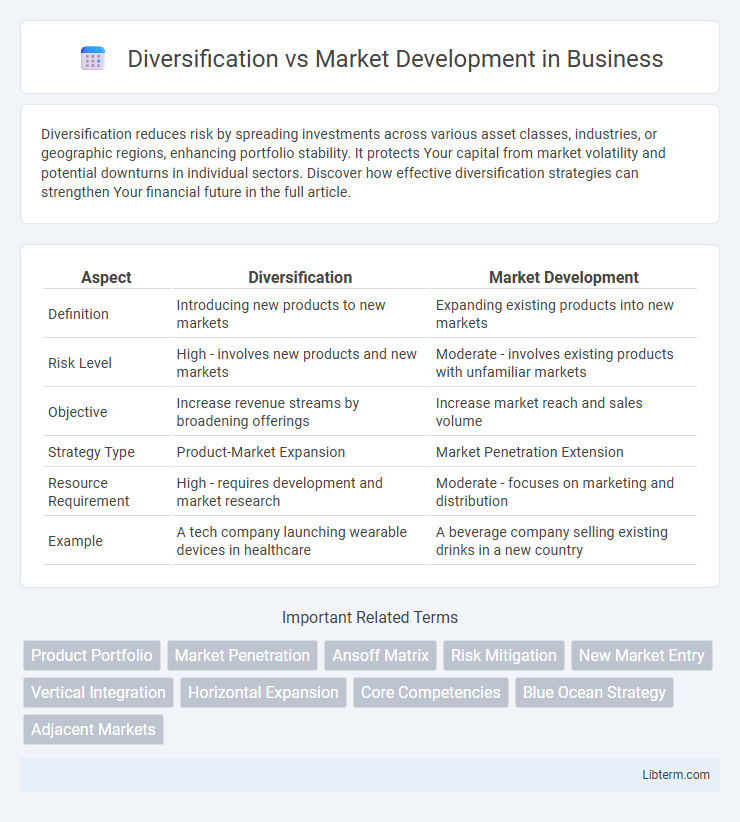Diversification reduces risk by spreading investments across various asset classes, industries, or geographic regions, enhancing portfolio stability. It protects Your capital from market volatility and potential downturns in individual sectors. Discover how effective diversification strategies can strengthen Your financial future in the full article.
Table of Comparison
| Aspect | Diversification | Market Development |
|---|---|---|
| Definition | Introducing new products to new markets | Expanding existing products into new markets |
| Risk Level | High - involves new products and new markets | Moderate - involves existing products with unfamiliar markets |
| Objective | Increase revenue streams by broadening offerings | Increase market reach and sales volume |
| Strategy Type | Product-Market Expansion | Market Penetration Extension |
| Resource Requirement | High - requires development and market research | Moderate - focuses on marketing and distribution |
| Example | A tech company launching wearable devices in healthcare | A beverage company selling existing drinks in a new country |
Understanding Diversification: Definition and Types
Diversification is a strategic growth approach where a company expands its product lines or enters new markets to reduce risks associated with relying on a single market or product. Types of diversification include related diversification, where new products or services are connected to existing business operations, and unrelated diversification, which involves entering entirely different industries to spread market risks. This strategy enhances competitive advantage by leveraging existing capabilities or exploring novel opportunities for revenue generation.
Defining Market Development: Core Concepts
Market development involves expanding a company's reach by introducing existing products into new geographical areas, customer segments, or distribution channels. This strategy focuses on leveraging current product strengths to capture untapped markets, thereby increasing overall market share. Unlike diversification, which entails creating new products for new markets, market development minimizes risk by staying within familiar product lines while exploring new customer bases.
Key Differences Between Diversification and Market Development
Diversification involves entering new markets with new products, significantly increasing business scope and risk, while market development focuses on expanding the reach of existing products into new geographic areas or customer segments. Diversification requires substantial investment in research, development, and market analysis, whereas market development leverages existing product strengths and brand recognition to gain new customers. The strategic goal of diversification is growth through innovation and risk spreading, whereas market development aims at maximizing current product value through expansion.
Strategic Importance of Diversification
Diversification plays a crucial role in corporate growth strategies by enabling companies to enter new markets or industries, reducing dependence on existing products and mitigating risks associated with market fluctuations. It fosters innovation and resource utilization by leveraging core competencies into different sectors, which can create new revenue streams and enhance competitive advantage. Compared to market development, diversification offers greater strategic importance due to its potential to provide long-term sustainability through business portfolio expansion and risk dispersion.
Advantages and Risks of Market Development
Market development expands a company's reach by targeting new customer segments or geographic areas, leveraging existing products to generate additional revenue streams and increase market share. Advantages include reduced reliance on current markets, access to untapped demand, and potential economies of scale. Risks involve misjudging customer needs in new markets, cultural differences, higher marketing costs, and potential resource strain that could impact core operations.
When to Choose Diversification Over Market Development
Choose diversification over market development when existing markets are saturated or show limited growth potential, necessitating entry into new industries or product segments. Diversification is ideal if a company possesses unique capabilities or resources that can create competitive advantages in unrelated markets, reducing reliance on current market dynamics. This strategy mitigates risks associated with market dependency and taps into alternative revenue streams for long-term growth.
Case Studies: Successful Diversification Strategies
Successful diversification strategies often involve companies expanding their product lines or entering new markets to reduce risk and capitalize on growth opportunities. For example, Amazon diversified from its core e-commerce platform into cloud computing with Amazon Web Services, achieving significant revenue growth and market dominance. Similarly, Samsung expanded beyond electronics manufacturing to include heavy industries and financial services, demonstrating diversification's role in building resilience and sustaining long-term competitiveness.
Case Studies: Effective Market Development Examples
Apple's expansion into China exemplifies successful market development by tailoring products and marketing strategies to local consumer preferences, driving substantial revenue growth. Starbucks strategically entered the Indian market through joint ventures and localized store designs, effectively capturing a new customer base. These cases highlight how understanding regional market dynamics and customizing offerings can optimize market development outcomes.
Evaluating Market Conditions for Strategic Decision-Making
Evaluating market conditions for diversification versus market development requires analyzing market saturation, growth potential, and competitive intensity. Diversification thrives when existing markets stagnate or risk increases, necessitating entry into new product lines or industries, while market development suits expanding current offerings into untapped geographic or demographic segments. Strategic decision-making depends on data-driven assessments of customer demand trends, regulatory environments, and technological advancements influencing market readiness and profitability.
Conclusion: Selecting the Best Growth Strategy
Choosing the optimal growth strategy hinges on aligning business objectives with market conditions and resource capabilities. Diversification offers risk mitigation and entry into new industries, while market development leverages existing products to capture untapped customer segments. A thorough analysis of competitive landscape, customer needs, and internal strengths determines whether diversification or market development maximizes sustainable growth.
Diversification Infographic

 libterm.com
libterm.com